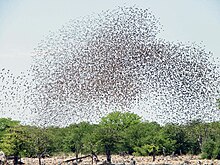Quelea /ˈkwiːliə/ is a genus of small passerine birds that belongs to the weaver family Ploceidae, confined to Africa. These are small-sized, sparrow- or finch-like gregarious birds, with bills adapted to eating seeds. Queleas may be nomadic over vast ranges; the red-billed quelea is said to be the most numerous bird species in the world.[2]
| Quelea | |
|---|---|

| |
| Red-billed quelea (Quelea quelea) | |
| Scientific classification | |
| Domain: | Eukaryota |
| Kingdom: | Animalia |
| Phylum: | Chordata |
| Class: | Aves |
| Order: | Passeriformes |
| Family: | Ploceidae |
| Genus: | Quelea Reichenbach, 1850 |
| Type species | |
| Loxia sanguinirostris[1] Linnaeus, 1766
| |
| Species | |
Taxonomy edit
There are three species:
| Image | Scientific name | Common Name | Distribution |
|---|---|---|---|
| Quelea cardinalis | Cardinal quelea | Burundi, Democratic Republic of the Congo, Ethiopia, Kenya, Malawi, Rwanda, South Sudan, Tanzania, Uganda, and Zambia. | |
| Quelea erythrops | Red-headed quelea | Angola, Benin, Botswana, Burkina Faso, Burundi, Cameroon, Central African Republic, Chad, Republic of the Congo, Democratic Republic of the Congo, Ivory Coast, Equatorial Guinea, Ethiopia, Gabon, Gambia, Ghana, Guinea, Guinea-Bissau, Kenya, Liberia, Malawi, Mali, Mozambique, Niger, Nigeria, Rwanda, São Tomé and Príncipe, Senegal, Sierra Leone, South Africa, South Sudan, Swaziland, Tanzania, Togo, Uganda, Zambia, and Zimbabwe. | |
| Quelea quelea | Red-billed quelea | Subsaharan Africa, but absent from Madagascar, and avoiding rainforest, high altitude and South Africa's south coast |
Phylogeny edit
Based on recent DNA-analysis, the red-billed quelea is sister to a clade that consist of both remaining species of the genus Quelea, namely Q. cardinalis and Q. erythrops. The genus belongs to the group of true weavers (subfamily Ploceinae), and is most related to Foudia, a genus of six or seven species that occur on the islands of the western Indian Ocean. This clade is sister to the Asian species of the genus Ploceus.
The following tree represents current insight of the relationships between the species of Quelea, and their closest relatives.[3]
Impact on agriculture edit
Q. quelea is a major pest to small-grain cereal crops in much of sub-Saharan Africa; the kernels of corn are too big for it. Q. erythrops may cause substantial damage to rice. Q. cardinalis is not known to raid crops.[4]
References edit
- ^ "Ploceidae". aviansystematics.org. The Trust for Avian Systematics. Retrieved 2023-07-16.
- ^ Sekercioglu, Cagan Hakki (2006). "Foreword". In Josep del Hoyo; Andrew Elliott; David Christie (eds.). Handbook of the Birds of the World, Volume 11: Old World Flycatchers to Old World Warblers. Barcelona: Lynx Edicions. p. 48. ISBN 978-84-96553-06-4.
- ^ De Silva, Thilina N.; Peterson, A. Townsend; Bates, John M.; Fernandoa, Sumudu W.; Girard, Matthew G. (2017). "Phylogenetic relationships of weaverbirds (Aves: Ploceidae): A first robust phylogeny based on mitochondrial and nuclear markers". Molecular Phylogenetics and Evolution. 109: 21–32. doi:10.1016/j.ympev.2016.12.013. PMID 28012957. S2CID 205841906.
- ^ Oschadleus, H.D. (2001). "An updated bibliography of the African Quelea species". South African Journal of Science. 97 (7/8). National Research Foundation Pretoria South Africa: 339–340. cited on "Abstract - An updated bibliography of the African Quelea species". Invasive Species Compendium. Retrieved 2017-05-04.